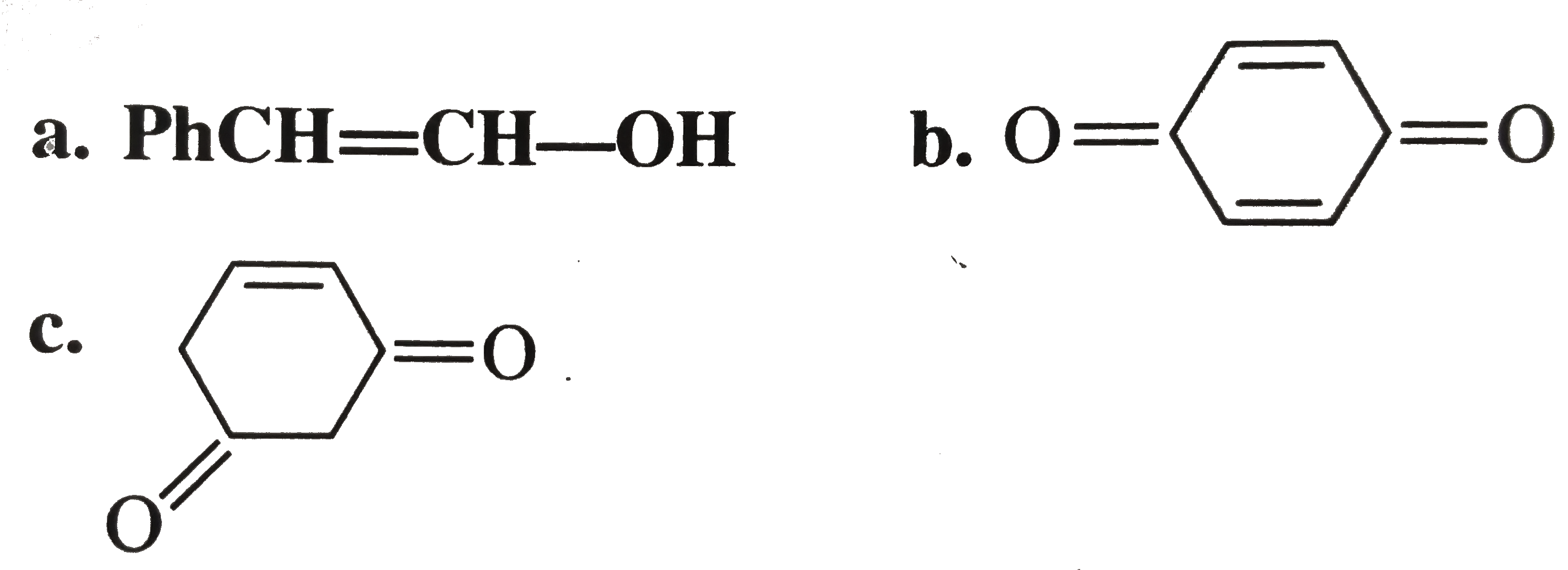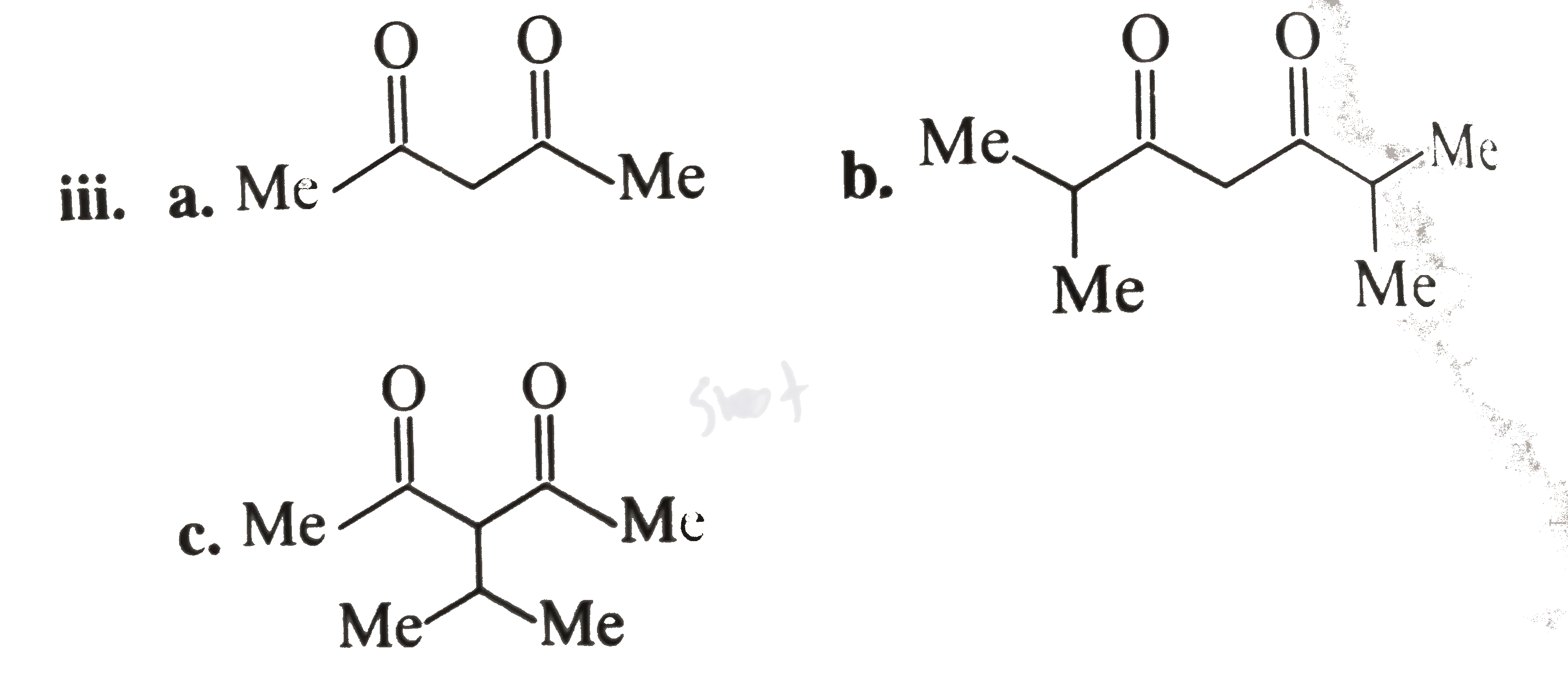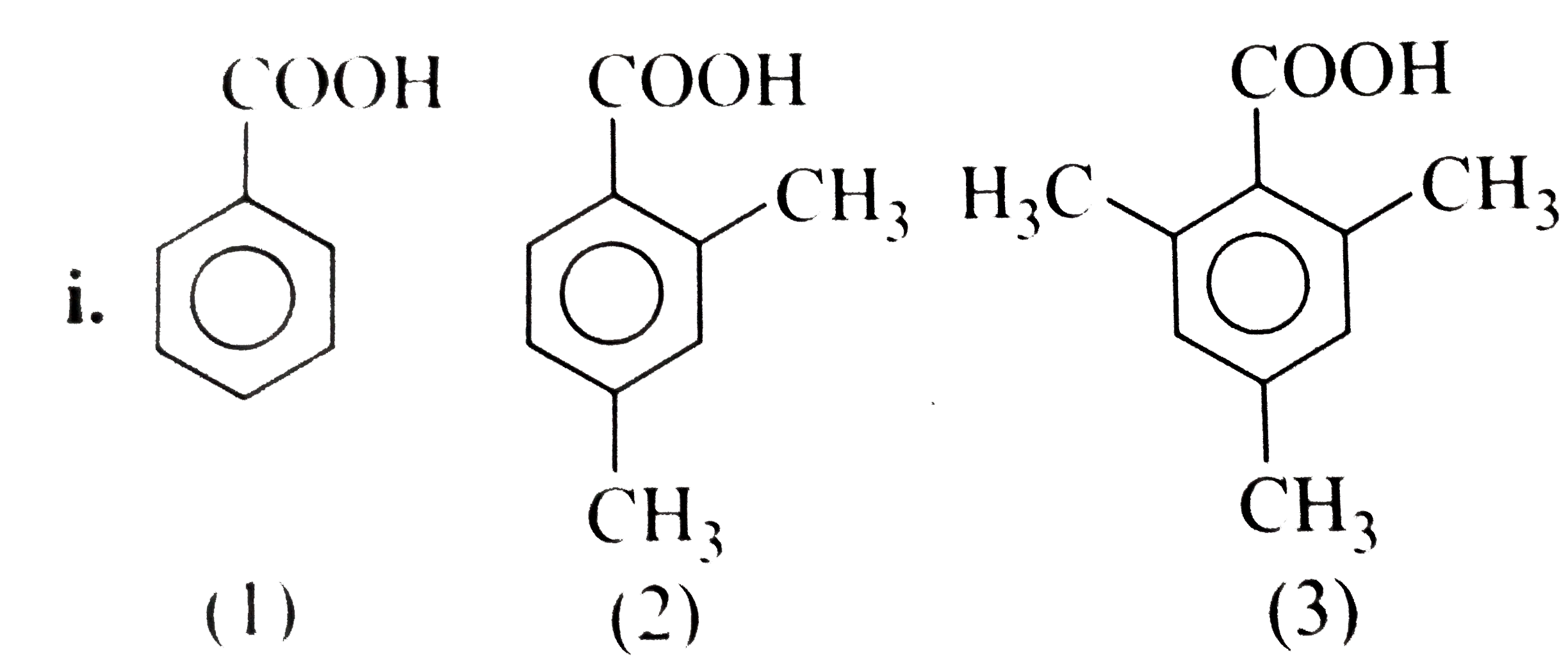Arrange the following in the increasing order of expected enol content.
i. CH3COCH2CHO
ii. CH3COCH3
iii. CH3CHO
iv. CH3COCH2COCH3
iii<ii<iv
iii<ii<i<iv
i<iv<ii<iii
iv<i<ii<iii
The correct Answer is:B
To determine the increasing order of expected enol content for the given compounds, we need to analyze each compound based on the number of alpha-hydrogens and the stability of the enol form. Enol content is generally higher for compounds that can stabilize the enol form through resonance or have more alpha-hydrogens available for tautomerization.
1. Identify the Compounds:
- i. CH₃COCH₂CHO (Compound A)
- ii. CH₃COCH₃ (Compound B)
- iii. CH₃CHO (Compound C)
- iv. CH₃COCH₂COCH₃ (Compound D)
2. Count the Alpha-Hydrogens:
- Compound A (CH₃COCH₂CHO):
- The alpha-carbon (the carbon adjacent to the carbonyl) is CH₂, which has 2 alpha-hydrogens.
- Compound B (CH₃COCH₃):
- The alpha-carbon is CH₃, which has 3 alpha-hydrogens.
- Compound C (CH₃CHO):
- The alpha-carbon is CH₃, which has 3 alpha-hydrogens.
- Compound D (CH₃COCH₂COCH₃):
- The alpha-carbons are CH₂ and CH₃, which totals to 5 alpha-hydrogens (2 from CH₂ and 3 from CH₃).
3. Analyze Enol Stability:
- Enol content is influenced by the stability of the enol form. More alpha-hydrogens generally lead to higher enol content.
- Compound A: Can form an enol, but less stable due to fewer alpha-hydrogens.
- Compound B: Moderate enol content due to 3 alpha-hydrogens.
- Compound C: Similar to Compound B, also has 3 alpha-hydrogens.
- Compound D: Highest enol content due to 5 alpha-hydrogens and potential for resonance stabilization.
4. Arrange in Increasing Order of Enol Content:
- Least Enol Content: Compound A (2 alpha-hydrogens)
- Next: Compound B and Compound C (3 alpha-hydrogens each)
- Most Enol Content: Compound D (5 alpha-hydrogens)
Final Order:
1. CH₃COCH₂CHO (Compound A)
2. CH₃COCH₃ (Compound B)
3. CH₃CHO (Compound C)
4. CH₃COCH₂COCH₃ (Compound D)
Increasing Order of Expected Enol Content:
CH₃COCH₂CHO<CH₃COCH₃=CH₃CHO<CH₃COCH₂COCH₃
---
- i. CH₃COCH₂CHO (Compound A)
- ii. CH₃COCH₃ (Compound B)
- iii. CH₃CHO (Compound C)
- iv. CH₃COCH₂COCH₃ (Compound D)
- Compound A (CH₃COCH₂CHO):
- The alpha-carbon (the carbon adjacent to the carbonyl) is CH₂, which has 2 alpha-hydrogens.
- Compound B (CH₃COCH₃):
- The alpha-carbon is CH₃, which has 3 alpha-hydrogens.
- Compound C (CH₃CHO):
- The alpha-carbon is CH₃, which has 3 alpha-hydrogens.
- Compound D (CH₃COCH₂COCH₃):
- The alpha-carbons are CH₂ and CH₃, which totals to 5 alpha-hydrogens (2 from CH₂ and 3 from CH₃).
- Enol content is influenced by the stability of the enol form. More alpha-hydrogens generally lead to higher enol content.
- Compound A: Can form an enol, but less stable due to fewer alpha-hydrogens.
- Compound B: Moderate enol content due to 3 alpha-hydrogens.
- Compound C: Similar to Compound B, also has 3 alpha-hydrogens.
- Compound D: Highest enol content due to 5 alpha-hydrogens and potential for resonance stabilization.
- Least Enol Content: Compound A (2 alpha-hydrogens)
- Next: Compound B and Compound C (3 alpha-hydrogens each)
- Most Enol Content: Compound D (5 alpha-hydrogens)
1. CH₃COCH₂CHO (Compound A)
2. CH₃COCH₃ (Compound B)
3. CH₃CHO (Compound C)
4. CH₃COCH₂COCH₃ (Compound D)
CH₃COCH₂CHO<CH₃COCH₃=CH₃CHO<CH₃COCH₂COCH₃
Topper's Solved these Questions
- ISOMERISMBOOK - CENGAGE CHEMISTRYCHAPTER - ISOMERISMEXERCISE - Assertion-Reasoning Type (Exercise)
5 Videos
- ISOMERISMBOOK - CENGAGE CHEMISTRYCHAPTER - ISOMERISMEXERCISE - Fill in the blanks (Exercise)
3 Videos
- ISOMERISMBOOK - CENGAGE CHEMISTRYCHAPTER - ISOMERISMEXERCISE - Single correct answer type
13 Videos
- IONIC EQUILIBRIUMBOOK - CENGAGE CHEMISTRYCHAPTER - IONIC EQUILIBRIUMEXERCISE - Archives Subjective
28 Videos
- NCERT BASED EXERCISEBOOK - CENGAGE CHEMISTRYCHAPTER - NCERT BASED EXERCISEEXERCISE - Chemical Equilibrium
72 Videos
Similar Questions
Keto-enol tautomerism is observed in :
(i) a.PhCHO , b.PhCOCH3
c. PhCOPh , d. PhCOCH2COCH3

(II) Arrange the following in the decreasing order of enol content:
(i) a.CH3COCH2CHO , b. CH3COCH3
c. CH3CHO , d. CH3COCH2COCH3
(ii) a. CH2(COOEt)2 (Diethyl malonate)
b. CH3COCH2COOEt(EAA)
c. CH3COCH2COCH3
d. PhCOCH2COCH3

(III) Give the decreasing order of enol content of ethyl acetoacetate in the following solvents:
a. Water b. Methanol
c. Benzene d. Acetone
View SolutionArrange the following in decreasing order of nucleophilic addition
CH3CHO,CH3COCH3,HCHO,C2H5COCH3
View Solution
Knowledge Check
Arrange the following compounds in decreasing orders of rate of hydration.
(X)CCl3CHO (Y)CH3CHO (Z)CH3COCH3 (W)CF3CHOAW gt Z gt X gt YBW gt X gt Y gt ZCW gt Y gt Z gt XDW gt Z gt Y gt X
Arrange the following compounds in increasing order of their property as indicated:
(i) CH3COCH3,C6H5COCH3,CH3CHO
(ii) Cl−CH2−COOH,F−CH2−COOH,CH3−COOH (acidic character)
View Solutiona. Acid halides, anhydrides, esters and amides, all of them contain (C=O) group but none of them gives test for (C=O) group, i.e., they do not form oximes, hydrazones, and DNP derivatives, etc. Why?
b. Arrange the following in the decreasing order of nucleophilic addition.
i. (1)−CHO
(2)−COCH3
(3)−COOH
(4)−COCI
(5)−CONH2
(6)−COOCH3
(7)−COOΘ
ii. (1)CH3CHO
(2)CH3COCH3
(3)HCHO
(4)CH2H5CH2COCH3
iii. (1)CH3COCH3
(2)C6H5COCH3
(3)C6H5COC6H5
(4)C6H5CH2COCH3
iv. (1)C6H5CHO
(2)ρ−CH3.C6H4.CHO
(3)ρ−OH.C6H4.CHO
(4)ρ−NO2.C6H4.CHO
(5)ρ−CI.C6H4.CHO
v. (1)HCHO
(2)CH3CHO
(3)CH3COCH3
(4)CI3CCHO
c. Arrange the following in the increasing order of ease of hydrolysis.
(1)CCH3COOC2H5
(2)CH3COCI
(3)(CH3CO)2O
(4)CH3CONH2
d. Arrange the following in the increasing order of ease of acid-catalysed esterification of:
i.
ii. (1)CH3CH2COOH
(2)(CH3)2CHCOOH
(3)(CH3)3CCOOH
iii. (1)CH3CH2CH2OH
(2)CH3CHOHC2H5
(3)(CH3)2C(OH)C2H5
e. Arrange the following esters in decresing order of ease of alkaline hydrolysis.
i. (1)HCOOCH3
(2)CH3COOCH3
(3)(CH3)3CCOOCH3
(4)(CH3)2CHCOOCH3
ii. (1)CH3COOCH3
(2)CH3COOC(CH3)3
(3)CH3COOCH(CH3)2
(4)CH3COOCH2CH3
iii. (1)C6H5COOCH3
(2)ρ−CH3O−C6H4−CCOOCH3
(3)ρ−NO2−C6H4−COOCH3
(4)ρ−Cl−C6H4−COOCH3
View SolutionArrange the following in order of increasing reactivity towards nucleophilic addition reactions
C6H5COCH3,CH3CHO,CH3COCH3.
View SolutionArrange the following in the decreasing order of their reactivity towards nucleophilic addition reaction :
HCHO,CH3COCH3,CH3CHO
View SolutionArrange the following compounds in increasing order of their boilnig points:
CH3CH2CH2CH2OH,CH3CH2COCH3,CH3CH2OCH2CH3.
View SolutionArrange the following in the order of their incresing reactivity towards HCN:
CH3CHO,CH3COCH3,HCHO,C2H5COCH3
View SolutionArrange the following in the order of their incresing reactivity towards HCN:
CH3CHO,CH3COCH3,HCHO,C2H5COCH3
View Solution
